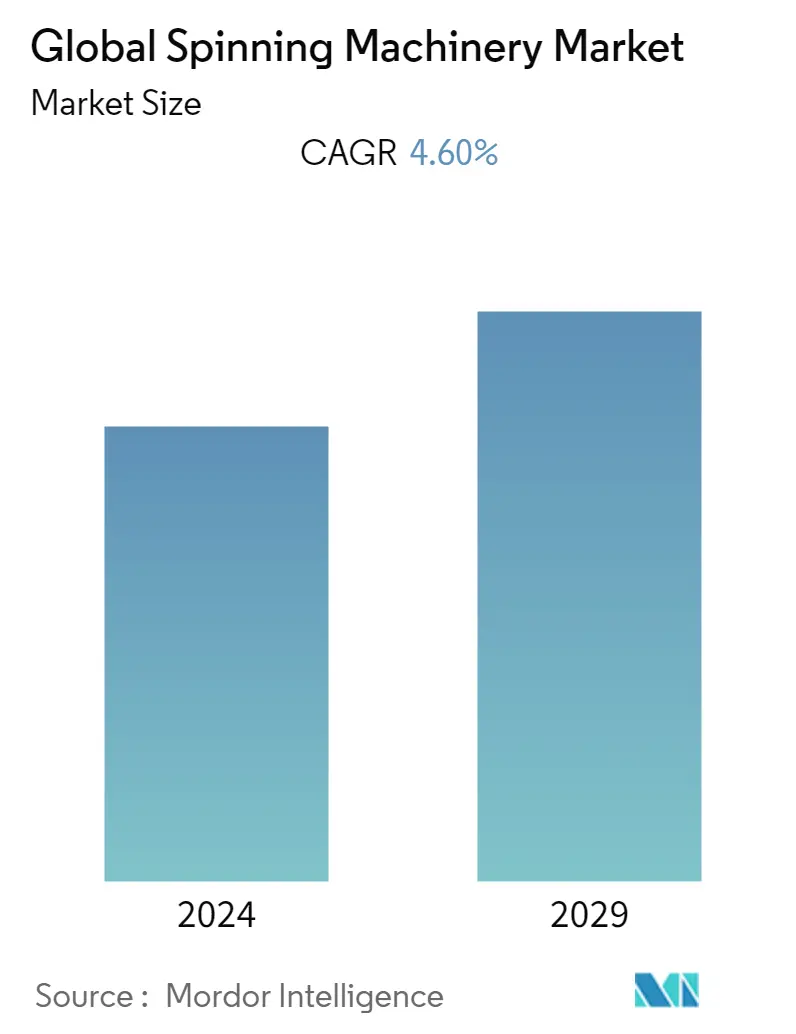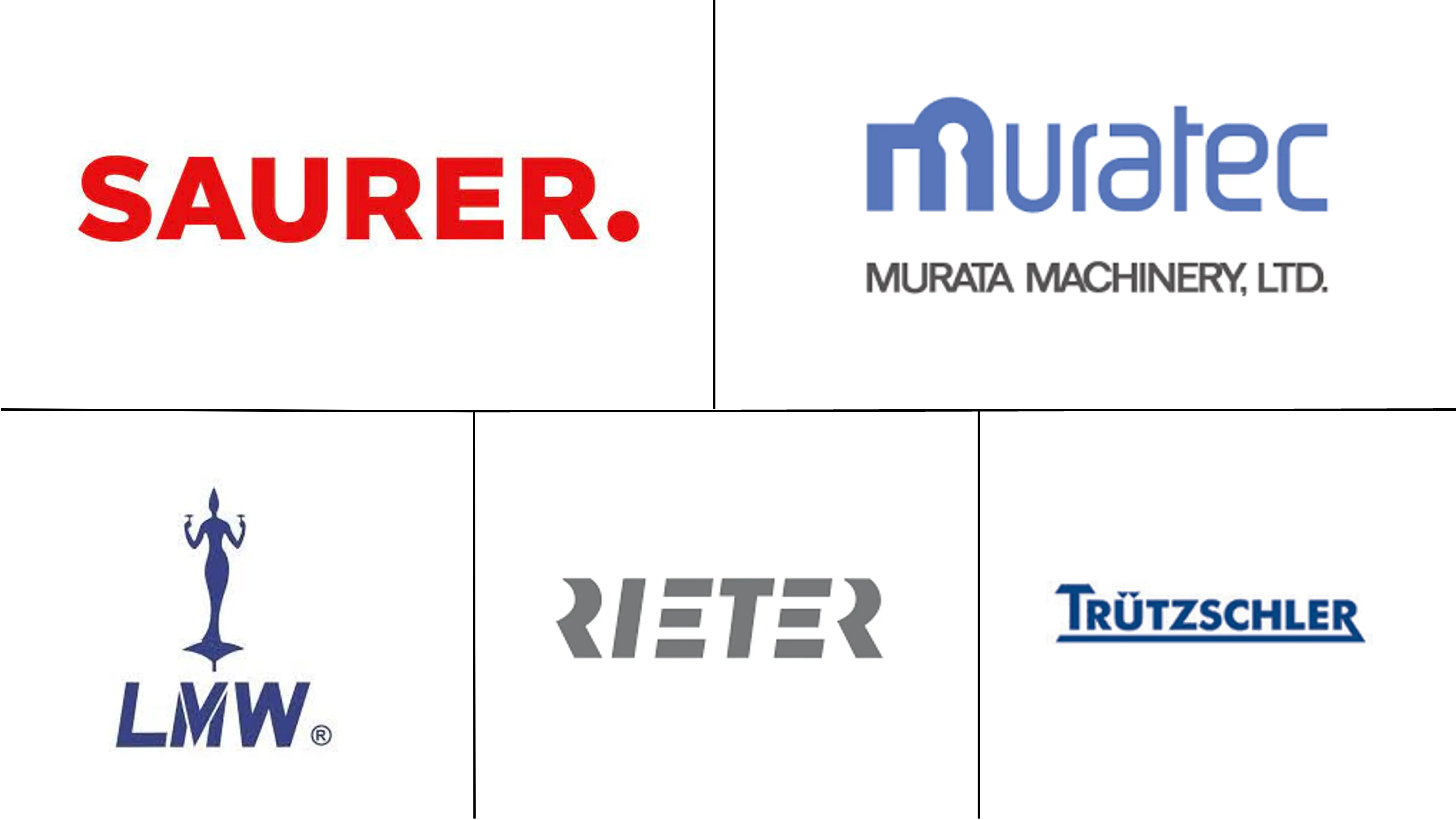Market Size of Global Spinning Machinery Industry

| Study Period | 2020 - 2029 |
| Base Year For Estimation | 2023 |
| CAGR | 4.60 % |
| Fastest Growing Market | Asia-Pacific |
| Largest Market | Asia-Pacific |
| Market Concentration | Low |
Major Players
*Disclaimer: Major Players sorted in no particular order |
Spinning Machinery Market Analysis
The Global Spinning Machinery Market is expected to grow at a CAGR of 4.6% over the forecast period of 2022-2027.
The COVID-19 outbreak has compelled government officials to take drastic measures. To prevent the virus from spreading, several emerging and developed countries imposed partial or total lockdowns. Under the lockdown, the manufacture of spinning machinery and the provision of related services were limited to permissible limits.
Spinning machinery is intended to produce yarn from textile fibers, comprising natural, synthetic, or blended fibers. These machines were manufactured during the Industrial Revolution in order to mass-produce cotton textile products. Presently, the spinning machinery setup involves considerable capital investment along with prominent infrastructure, as it includes installing a line of machines with an intention to carry out a series of functions from fiber stage to yarn stage.
Major production centers of cotton yarn manufacturing are concentrated in China, India, the U.S., Pakistan, Indonesia, Brazil, Turkey, South Korea, Italy, Egypt, and Japan. Accordingly, the top spinning machinery suppliers focus on catering to these regions.
A macro-level factor driving factor in the spinning machinery market is the rising contribution of the fashion industry to the overall GDP. Another factor driving the technical textiles industry across the globe such as automotive textiles and geotextiles, which demand high-end performance from industrial yarns.
A prominent issue facing the industry is that very few new players are involved in manufacturing yarn. New sales that account on the yearly basis are the result of the expansion of plant capacity or replacements of older machines. Accordingly, the buyers of spinning machinery have higher bargaining power.
However, the yarn industry still requires mass production of different types of yarns, and accordingly, manufacturers of spinning machinery are consistently working on innovations in order to cater to customers with better productivity.
Spinning Machinery Industry Segmentation
Spinning machinery is used for roving cotton into workable yarns or threads. These yarns or threads are then used to make clothing and other products. The Global Spinning Machinery market is segmented by Machine Type (Ring and Rotor Spinning), by Material (Natural, Synthetic and Others), by Application (Clothing, Textile and Other Industry) and by Geography (North America (United States, Mexico and Canada), Asia-Pacific (China, Japan, India, Bangladesh, Turkey, South Korea, Australia, Indonesia and Rest of Asia), Europe (Germany, France, United Kingdom, Italy, Spain, Russia and Rest of Europe), Middle East & Africa (Egypt, South Africa, Saudi Arabia and Rest of Middle East & Africa) and South America (Brazil, Argentina, Rest of South America)). The report offers market size and forecasts for Global Spinning Machinery market in value (USD billion) for all above segments.
| By Machine Type | |
| Ring | |
| Rotor Spinning |
| By Material | |
| Natural | |
| Synthetic | |
| Others |
| By Application | |
| Clothing | |
| Textile | |
| Other Industry |
| By Geography | |||||||||
| |||||||||
| |||||||||
| |||||||||
| |||||||||
|
Global Spinning Machinery Market Size Summary
The global spinning machinery market is poised for steady growth, driven by the increasing demand for yarn production from both natural and synthetic fibers. This demand is largely fueled by the expanding fashion industry and the technical textiles sector, which includes automotive and geotextiles. The market is characterized by significant capital investment and infrastructure requirements, with major production centers located in countries such as China, India, and the United States. Despite the competitive and fragmented nature of the market, leading companies like Rieter and Saurer AG are focusing on innovation to enhance productivity and meet the evolving needs of the industry. The COVID-19 pandemic initially posed challenges, but the market has shown resilience, with minimal impact on the non-woven fabric segment, which continues to grow due to its applications in healthcare and personal care.
The spinning machinery industry faces challenges such as limited new entrants and high buyer bargaining power, as market growth is primarily driven by plant capacity expansions and machine replacements. However, the ongoing demand for diverse yarn types ensures that manufacturers remain committed to innovation. The Asia-Pacific region dominates the market, with increasing demand for non-woven fabrics driven by sectors like construction and healthcare. In India and China, the rising penetration of hygiene products and the growing market for feminine and baby care products are significant contributors to market expansion. Additionally, the fast fashion market is experiencing growth, supported by the youth population's preference for affordable and trendy clothing, further driving the demand for spinning machinery.
Global Spinning Machinery Market Size - Table of Contents
-
1. MARKET INSIGHTS
-
1.1 Current Market Scenario
-
1.2 Market Dynamics
-
1.2.1 Drivers
-
1.2.2 Restraints
-
1.2.3 Opportunities
-
1.2.4 Industry Attractiveness - Porter's Five Forces Analysis
-
1.2.4.1 Bargaining Power of Suppliers
-
1.2.4.2 Bargaining Power of Consumers
-
1.2.4.3 Threat of New Entrants
-
1.2.4.4 Threat of Substitutes
-
1.2.4.5 Intensity of Competitive Rivalry
-
-
-
1.3 Technological Trends
-
1.4 Government Regulations
-
1.5 Value Chain / Supply Chain Analysis
-
1.6 Impact of COVID-19 on the Market
-
-
2. MARKET SEGMENTATION (Market Size By Value)
-
2.1 By Machine Type
-
2.1.1 Ring
-
2.1.2 Rotor Spinning
-
-
2.2 By Material
-
2.2.1 Natural
-
2.2.2 Synthetic
-
2.2.3 Others
-
-
2.3 By Application
-
2.3.1 Clothing
-
2.3.2 Textile
-
2.3.3 Other Industry
-
-
2.4 By Geography
-
2.4.1 North America
-
2.4.1.1 United States
-
2.4.1.2 Canada
-
2.4.1.3 Mexico
-
-
2.4.2 Europe
-
2.4.2.1 United Kingdom
-
2.4.2.2 France
-
2.4.2.3 Italy
-
2.4.2.4 Spain
-
2.4.2.5 Germany
-
2.4.2.6 Russia
-
2.4.2.7 Rest of Europe
-
-
2.4.3 Asia-Pacific
-
2.4.3.1 India
-
2.4.3.2 China
-
2.4.3.3 Japan
-
2.4.3.4 South Korea
-
2.4.3.5 Southeast Asia
-
2.4.3.6 Australia
-
2.4.3.7 Rest of Asia-Pacific
-
-
2.4.4 Middle East & Africa
-
2.4.4.1 Saudi Arabia
-
2.4.4.2 United Arab Emirates
-
2.4.4.3 Qatar
-
2.4.4.4 South Africa
-
2.4.4.5 Rest of Middle East & Africa
-
-
2.4.5 South America
-
2.4.5.1 Argentina
-
2.4.5.2 Brazil
-
2.4.5.3 Chile
-
2.4.5.4 Rest of South America
-
-
-
Global Spinning Machinery Market Size FAQs
What is the current Global Spinning Machinery Market size?
The Global Spinning Machinery Market is projected to register a CAGR of 4.60% during the forecast period (2024-2029)
Who are the key players in Global Spinning Machinery Market?
Rieter, Saurer AG, Murata Machineery USA Inc., Lakshmi Machine Works Limited and Trutzschler are the major companies operating in the Global Spinning Machinery Market.

